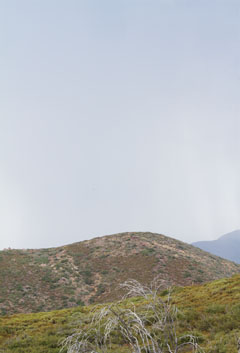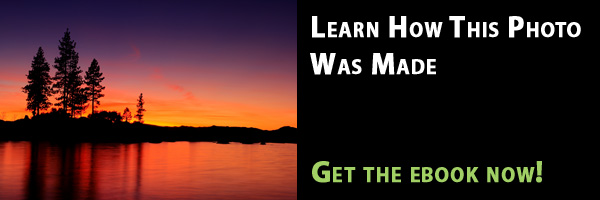
Plus, I’ve only heard thunder or seen lightning twice in my five years of living in Southern California. So, when the weather forecast keeps saying “thunderstorms,” I always think to myself, “yeah, right…”
Anyway, back to the photo-op that I missed.. Once my friend and I started seeing lightning off in the distance, we decided to stop and try to take a photo. It wasn’t raining where we were at, and the storm was at least a few miles north of us, so we felt safe standing around taking photos.
But, then I realized I know NOTHING about photographing lightning. Over the last few years, I’ve come across lots of articles on photographing lightning, but always ignored them because “hey, I live in Southern California, it doesn’t lightning often enough here!”
That’s when I came to another realization: the fact that it doesn’t lightning very often in Southern California is EXACTLY the reason why I should be prepared to photograph it, because rare events always make powerful images.
So, naturally, when I got home, I read everything I could about photographing lightning 🙂 And, once I found out that photographing lightning during the day is nearly impossible, I didn’t feel so bad about missing a great shot 😉
This experience has also got me thinking about other things I should be prepared to photograph, even if they rarely occur where I live. Because the fact that they so rarely occur here, is exactly the reason why they’re worth photographing.
Have you had a similar experience?
If you’ve had a similar experience, where you weren’t prepared to photograph something special, then please tell us about it by leaving a comment below! Thanks 🙂
Get more great tips in our free weekly newsletter.
 About the Author: Steve Berardi is a naturalist, photographer, software engineer, and founder of PhotoNaturalist. You can usually find him hiking in the beautiful mountains and deserts of southern California.
About the Author: Steve Berardi is a naturalist, photographer, software engineer, and founder of PhotoNaturalist. You can usually find him hiking in the beautiful mountains and deserts of southern California.

Where were you hiking? Looks like my neck of the woods.
I live in Central New York and we have weather events all the time. Sure wish I had my camera on the day I spotted a rainbow – not the type which is common, but this one was shooting straight up into the clouds. A friend was able to capture it on her point and shoot!
I live in Pennsylvania and spend a lot of time outside photographing wild birds with a long lens and a heavy metal tripod. Thunderstorms are a common event here during the summer. They can be severe and very dangerous. Oftentimes, men working or playing outside are hit by lightening. When I see black clouds rolling across the cornfields as I’m shooting in a wetlands far from shelter, I run! And trying to move fast with clanking, heavy equipment is a panicky, unpleasant experience. God bless you for being able to enjoy your infrequent storms!
Derek – I was on the Noble Canyon Trail in Cleveland NF, near Pine Valley. It was my first time in that area, and I really enjoyed it–can’t wait to get back!
Judith – That’s too bad you missed a rainbow shot! I missed one of those once too.. but it only lasted for a few minutes, so I didn’t have much of a chance anyway 🙁
Kelly – I agree, it’s important to put safety first. Luckily, this storm we watched over the weekend was a few miles north of us (and moving farther northeast), so we felt safe from the storm. It was even sunny where we were standing 🙂
I missed some fantastic shots this week….out of the blue…hopefully once in a lifetime shots. We were given about 8 minutes notice to evacuate our home in the Taylor Bridge Wildfire in Cle Elum, WA. The county sheriff said, You must leave right now! I did grab my camera bag and tripod and jumped in the car. We were not allowed to stick around and I could see that the sky was getting pretty dramatic. Amazingly, my house was still standing the next morning. A professional photographer was able to take the picture I should have gotten as the fire swept around my home Tuesday afternoon. Most of the nation has seen the dramatic shots of this house surrounded by fire, but still standing. I missed the shot, but am so thankful for the miracle of a house still standing though it had been surrounded by fire. God is good!
Sharon – that’s too bad you missed out on the photo, but I’m glad you and your house are okay! 🙂
So Steve, what’s the answer about shooting lightening during the daytime? Why is it so tough? And what camera were you using? I often see lightening during the day/night during the monsoon weather (southern AZ) – this year especially. I’m also on the quest to figure out how to shoot meteors and the milky way. I’ve just figured out the moon – ISO1000, F4.6 – on my Nikon D50. I could shoot these settings easier on my film camera the Minolta SRT101. Any suggestions for the night sky?
I too have missed some opportunities because I didn’t have my camera available. My solution was that when I needed a new phone the most important feature was the camera. I got a phone with a large megapixel camera. It has paid off. I saw a full rainbow that was huge. I took several pairs of pictures and then stitched together the best pair. I was amazed to see such a rainbow and then the camera phone caught it.
Connie – It’s difficult to photograph lightning during the day because it’s impossible to predict when it’ll happen. And, since it’s so bright out, you can’t leave your shutter open and wait for the lightning, like you can when it’s dark out.
If you wait for the lightning flash before you shoot the photo, you’ll always be too late. So, it turns out your only options are taking a ton of photos repeatedly (and hoping you just happen to get a photo at the same time as a lightning strike), or use a lightning trigger (which detects lightning and triggers your shutter).
It’s a lot easier to photograph lightning at night, because then you just set your camera to BULB mode, and keep the shutter open until lightning strikes, then close the shutter.
Here’s a great tutorial I found on photographing lightning:
http://www.weatherscapes.com/techniques.php?cat=lightning&page=lightning
For photographing the Milky Way, I’d recommend using a very wide aperture (f/2.8 or f/4), a high ISO like 1600 or 3200, and a shutter speed of somewhere around 30 seconds (any longer than that and you start to get star trails).
My friends think that I had a doctor surgically attach my camera to my hand because it is never more than a couple of feet from me. Never.